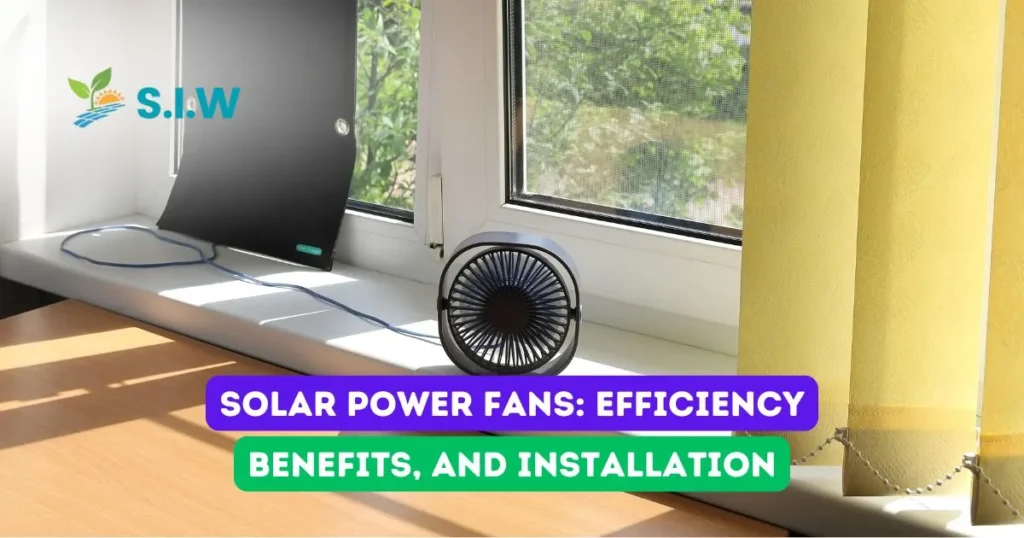In the evolving world of sustainable technology, solar power fans have emerged as a game-changer, offering a fusion of environmental responsibility and innovative functionality. As energy costs rise and environmental concerns escalate, solar power fans provide an excellent solution to cooling needs while reducing reliance on traditional electricity sources. This comprehensive guide delves into the benefits, types, and installation of solar power fans, ensuring you are well-informed and prepared to make the most of this cutting-edge technology.
What Are Solar Power Fans?
Solar power fans are ventilation systems powered entirely by solar energy. These fans utilize solar panels to capture sunlight and convert it into electricity, which is then used to operate the fan. This renewable energy source makes solar power fans an eco-friendly alternative to conventional electric fans and air conditioning systems.
Key Benefits of Solar Power Fans
1. Energy Efficiency and Cost Savings
One of the primary advantages of solar power fans is their remarkable energy efficiency. By harnessing sunlight, these fans operate without drawing electricity from the grid, which translates into significant cost savings on your energy bills. With solar power fans, you can enjoy consistent cooling at no additional cost once the system is installed.
2. Environmental Impact
Solar power fans contribute to reducing your carbon footprint. Unlike traditional fans that rely on fossil fuels, solar power fans use clean, renewable energy, minimizing greenhouse gas emissions. This makes them an excellent choice for environmentally conscious individuals looking to make a positive impact.
3. Low Maintenance Requirements
Solar power fans are designed with durability and low maintenance in mind. The absence of moving parts in the solar panel system means there are fewer components to service or replace. Regular cleaning of the panels and occasional checks are typically sufficient to keep the system functioning optimally.
4. Versatility and Installation Flexibility
Solar power fans come in various designs and sizes, making them versatile for different applications. Whether you need a fan for your home, greenhouse, or industrial setting, there’s a solar power fan suited to your needs. Additionally, their installation is relatively straightforward, as they do not require complex wiring or extensive modifications.
Types of Solar Power Fans
1. Roof-Mounted Solar Fans
Roof-mounted solar fans are commonly used in residential and commercial buildings. These fans are installed on the roof and use solar panels to power the ventilation system. They are particularly effective in removing hot air from attics, reducing heat buildup and lowering indoor temperatures.
2. Solar Attic Fans
Solar attic fans are designed specifically for attic ventilation. They help in maintaining a cooler attic environment by expelling hot air, which can significantly reduce the load on your air conditioning system. This not only enhances comfort but also extends the lifespan of your roofing materials.
3. Solar Exhaust Fans
Solar exhaust fans are ideal for industrial or large-scale applications. These fans are used to ventilate areas such as greenhouses, barns, or factories, where efficient air circulation is crucial. They help in removing excess heat, moisture, and pollutants, ensuring a healthier environment.
4. Portable Solar Fans
For those who need mobility, portable solar fans offer a practical solution. These fans are powered by small solar panels and are perfect for outdoor activities like camping, picnicking, or tailgating. They provide a convenient way to stay cool while on the move.
Installing Solar Power Fans: A Step-by-Step Guide
1. Assess Your Needs
Before purchasing a solar power fan, evaluate your specific cooling requirements. Consider factors such as the size of the area you need to ventilate, the amount of sunlight available, and any existing ventilation systems.
2. Choose the Right Fan
Select a solar power fan that matches your needs. For instance, if you need to cool an attic, a roof-mounted or attic fan would be suitable. For portable use, opt for a portable solar fan. Ensure the fan’s specifications align with your cooling needs and installation location.
3. Install the Solar Panels
Install the solar panels in a location that receives maximum sunlight exposure. This is typically on a roof or a south-facing wall. The panels should be mounted securely to avoid any potential damage or dislodgement.
4. Mount the Fan
Once the solar panels are installed, mount the fan in the desired location. Ensure that the fan is positioned correctly to maximize airflow and ventilation. Follow the manufacturer’s instructions for proper installation to ensure optimal performance.
5. Connect the Wiring
Connect the wiring between the solar panels and the fan. Most solar power fans come with pre-installed wiring or connectors, making the process relatively simple. Double-check all connections to ensure they are secure and correctly installed.
6. Test the System
After installation, test the fan to ensure it operates correctly. Verify that the solar panels are receiving adequate sunlight and that the fan runs smoothly. Make any necessary adjustments to optimize performance.
Final Thoughts
Solar power fans represent a forward-thinking approach to energy-efficient cooling solutions. By leveraging the power of the sun, these fans offer significant cost savings, reduce environmental impact, and provide versatile applications for various needs. Whether you are looking to enhance your home’s ventilation, cool an industrial space, or enjoy portable cooling, solar power fans are a reliable and eco-friendly choice.








